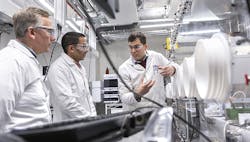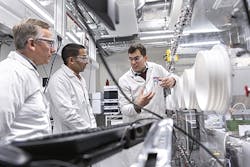Flow Chemistry Gains New Focus
A partnership announced between BASF, Ludwigshafen, Germany, and Imperial College London (ICL) will involve a number of flow chemistry projects at the university’s Center for Doctoral Training (CDT) in next-generation synthesis and reaction technology.
“This research is a real opportunity to complement world-scale production with a more flexible alternative,” says Christian Holtze, senior research engineer at BASF with a background in microfluidics. “While we already use continuous processes routinely to manufacture chemicals at large — typically kilotonne-scale, a key challenge is to implement flow chemistry at smaller kilogramme scales, specifically for R&D and the manufacture of low-volume, high-value chemicals, including speciality chemicals, which to date are predominantly made in batch processing, for example in stirred tank reactors,” he adds.
Holtze recognized microfluidics had greater value to BASF in reaction chemistry than formulation chemistry, and thus looked at how to boost the use of flow chemistry in its operations. His role now is matching BASF’s needs, mainly in agrochemicals, with ICL’s flow chemistry expertise.
[pullquote]
BASF in fall 2020 will fully fund 10 PhD students, a local support structure at ICL for at least four years, and two other PhD students at Cambridge University, Cambridge, U.K. The company could make funds available for more projects in the future.
The work will be conducted at the Molecular Sciences Research Hub (MSRH), ICL’s new home for chemistry at its White City campus in West London. MSRH research facilities include advanced flow chemistry, automation and data science technologies.
“Chemistry students are traditionally taught to use round-bottom flasks for reactions. One of our priorities is to promote better awareness of other reaction technologies, particularly flow chemistry, as part of their essential training of our CDT program, and hopefully we can extend this further to undergraduate teaching,” notes Mimi Hii, professor of catalysis at ICL. “While continuous flow processes are routinely taught in chemical engineering courses, the basic concept is hardly mentioned in chemistry courses at any university. There is also a need to better understand the control and automation technology involved with flow chemistry,” she adds.
Figure 1. The Center for Rapid Online Analysis of Reactions (ROAR) will allow students
to better understand the language and tools used by other disciplines involved in flow chemistry work. Source: Thomas Angus/Imperial College London
This knowledge will be further developed at MSRH’s Center for Rapid Online Analysis of Reactions (ROAR).
“This is a suite of highly automated reactors — including continuous flow equipment — and instrumentation that generate a large quantity of high-quality data,” says Hii, who is also director of ROAR.
The idea here is that CDT students will pick up skills, such as machine learning and Python programming, and so begin to better understand the language and tools used by other disciplines involved in flow chemistry work. “It’s a learning curve for everybody, but with the CDT we can address the skills gap between academics and industry,” believes Hii.
BASF also has grown a corporate flow chemistry research community at Ludwigshafen. It draws on 20 experts within the company dedicated to tackling the challenges involved in moving from lab- to commercial-scale flow chemistry production.
“The overall size of this program is owing to the challenge of implementing flow chemistry in industry: it must be considered in a holistic way, by providing a seamless workflow from early-stage lab experiments all the way to pilot scale and production concepts. Now is the right time to do this as more equipment related to flow chemistry is becoming commercially available. Also, first examples of best practice are coming from the pharmaceutical industry, while machine learning capabilities and computational power today are beyond anything that was available even a few years ago,” says Holtze.
“Business-wise, it’s about finding the best partners to collaborate with. That way you can develop the technology faster and it becomes easier to commercialize,” explains Darren Budd, commercial director (U.K. and Ireland), BASF. “We do a lot of scouring the globe for such technologies. Now we’ve got a solid base through the CDT and students will get some really good ideas about how we can use flow chemistry technology inline in our production processes. We’re all excited with where CDT work can go,” he adds.
For example, he believes the pandemic presents an opportunity here, with flow chemistry technologies helping produce products nearer to markets, thus avoiding some of the supply chain problems the virus caused. Flow chemistry may be game-changing, too, when hazardous chemicals needed in some processes are expensive and potentially dangerous to ship.
Seán Ottewell is Chemical Processing's editor at large. You can email him at [email protected].


